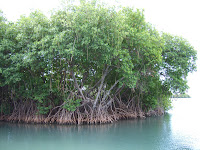 |
Although the green, brown, and red macroalgae play key roles in supporting the reef ecosystem, they are not the only large plants growing there. Two types of vascular plants, sea grasses and mangroves, are common around coral reefs. The ancestors of these true plants evolved to live on the land then moved back to the sea; therefore, they have many of the typical terrestrial plant adaptations such as roots and vascular systems. In addition, both mangroves and grasses form pollen and seeds. Once a year, grasses produce thousands of tiny underwater flowers that yield pollen grains that float in the water from one plant to another. After pollination, fertilized eggs mature into seeds that float away from the parent plants, sink, and start new beds of grass.
Besides reproducing sexually, sea grasses can spread asexually by sending out runners that generate upright shoots. In this way, they can quickly form large meadows on the sandy bottoms of lagoons. Sea grasses are not tolerant of intense wave action, so are usually found in the quieter regions of the reef. Sea grass beds are important sources of food for many marine animals including shellfish, fish, and turtles. In addition, they provide good hiding places for the young of many species and often serve as nurseries where juveniles can find plenty of food and protection from predators.
Mangroves are large plants that are found growing on the beaches of island reefs. A mature mangrove tree can reach heights of 26.2 to 32.8 feet (8 to 10 m). Mangroves are never completely submerged; however, their root systems form extensive networks in shallow salt water. The presence of mangrove roots slows down the rate at which sediment-laden water swirls around the shore. When fast-moving water slows, it can no longer support suspended material, so the soil in it settles. The mangrove roots trap and hold soil, helping to stabilize and expand shorelines. The roots also provide shade, hiding places, and food for animals. Many species of reefdwelling animals spend part of their lives among the roots.
Unlike sea grasses, mangroves produce above-water flowers. After pollination, egg cells develop into seeds on the trees. Seeds mature to seedlings before falling off the trees. If the tide is out when a seedling falls, it lands in the sediment and grows there. If the tide is in, the seedling drops into the water and is carried to a new location.
